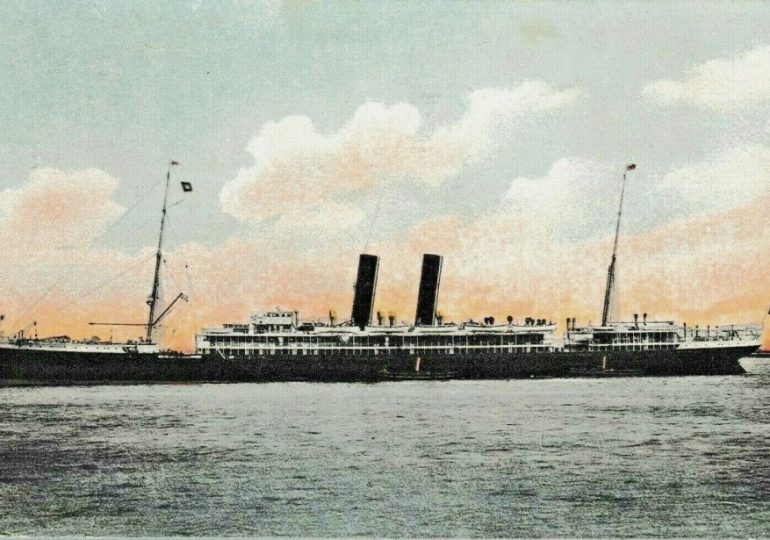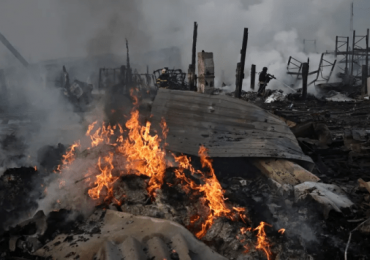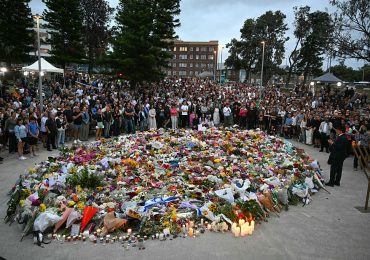A BRITISH ship that sank on the anniversary of the Titanic – killing 279 – has been found after more than a century lost in the depths of the sea.
Built as an ocean liner, the SS Arcadian was chartered by the Royal Navy in 1915 during the First World War and sank on April 15, 1917 when it was blasted by a German torpedo.
A postcard of the Arcadian in 1906, when it was the OrtonPen News
The sinking of the Arcadian after it was blasted by a torpedoPen News
This is the old deck, said to be in decent shape despite a century under seaPen News
The stern accommodation on the wreck after it was found deep below the surfacePen News
A Greek team tracked it down 107 years after the sinking
It was five years to the day after the Titanic disaster.
Titanic survivor Thomas Threlfall was on board and managed to elude the sinking of the Arcadian too.
Now her wreck has been found in the Aegean Sea 107 years later, discovered by a Greek team southeast of the Cycladic island of Sifnosat at a depth of 163 metres.
Team leader Kostas Thoctarides said: “The main feeling was excitement and a sense of satisfaction.
“For a long time we have been reading this thrilling story that has so many fascinating aspects.
“Then we saw the image of her on the seabed, something the human eye is seeing for the first time.
“For us it was a journey into the past and the history of the Arcadian, which is unknown to most people in Greece.”
The Arcadian was sunk en-route from Salonika in Greece – now Thessaloniki – to Alexandria in Egypt.
She’d headed west into the Cyclades in the hope of avoiding a German U-boat, detected at the island of Ikaria.
But she was unsuccessful.
Those on board had just completed an abandon ship drill when, at 5.44pm, the torpedo struck.
Fired by the UC-74, it blew into Arcadian on her starboard side, between the bridge and the foremast.
Captain Charles L Willats launched the lifeboats and ordered the ship be abandoned – this time for real.
Just five minutes after the explosion, Arcadian’s bow slipped below the water with her stern lifting out of the sea.
Her escort, HMS Sentinel, led the rescue, with French warships from Milos joining the effort some two-and-a-half hours later.
In all, 1,058 people were saved.
But 279 were not as fortunate – comprising 34 crew, ten members of the navy, and two civilians and the rest from the army.
Threlfall later said survivors were fortunate to have calm seas and warm weather, unlike the freezing water that killed those who fell into it off the Titanic.
The two-time shipwreck survivor said: “It was the same day and in the same month that the Titanic went down, and I have come safely out of both affairs.
“The Titanic stopped afloat for a couple of hours and we had time to turn around, but of course you could not live in the water that night.
“This time we had calm sea and warm weather, and you had a chance, but with the Titanic you died in the water almost as soon as you got in.”
A statement from Planet Blue, Thoctarides’ company, said the Arcadian was in “excellent condition” and was “one of the most impressive wrecks in Greece”.
It continued: “Time seems to have stopped at its sinking in 1917.”
It has also been left upright in the water, apparently because its bow hit the seabed while the stern was still sinking.
The hole caused by the torpedo is visible even now.
What happened to the Titanic?
The British ocean liner famously sank on April 15, 1912 after slamming into an iceberg in the freezing waters of the North Atlantic Ocean.
She was on her maiden voyage from Southampton to New York City, promising a journey of luxury and comfort.
It boasted a gymnasium, swimming pool, smoking rooms, fine restaurants and cafes along with its high-class cabins.
The Titanic’s advanced safety features for its era earned its “unsinkable” reputation.
But that proved a tragic irony when it struck the iceberg, leading to the deadliest ship sinking ever seen at the time.
Of approximately 2,224 on board, 1,496 died.
The disaster has captured the imagination of poets, writers and filmmakers ever since – most notably the 1997 movie Titanic, featuring Kate Winslet and Leonardo DiCaprio.
It remains the fourth highest grossing film of all time, making a bumper $2.264 billion in box office earnings.
For Mr Thoctarides it’s the culmination of a decades-long effort.
He said: “Our historical research on Arcadian started over 20 years ago by collecting information mainly from the British and German archives.
“Since the year 2000 we have been collecting data on the subject.
“As the wreck is located in a quite offshore area and a long journey is required to get there, we wanted to be as prepared as possible for these surveys.
“So we created quite a large file on Arcadian and when we had the opportunity to be in the area for underwater works we located it relatively quickly using sonar.”
No remains or personal artifacts were found on the ship, which was explored externally using an ROV (remotely operated vehicle).
Mr Thoctarides dedicated the discovery to those who perished on the Arcadian.
The ship was built in 1899 by the Vickers, Sons & Maxim company at their yard in Barrow-in- Furness, England.
She was initially named the Ortona but was renamed the Arcadian after being acquired by the Royal Mail Steam Packet Company in 1906.
Her killer, the German UC-74, was built in 1916 at the Vulcan Shipyard in Hamburg and sank a total of 37 ships during her career.
She was interned at Barcelona in 1918 after running out of fuel, surrendered to France in 1919 and broken up in Toulon two years later.
Kostas Thoctarides led the team that successfully found the wreckPen News
Thomas Threlfall, the two-time shipwreck survivorPen News
A British archival entry about the sinking of the ArcadianPen News
The ship remained relatively preserved considering its time under waterPen News
Leave a comment







